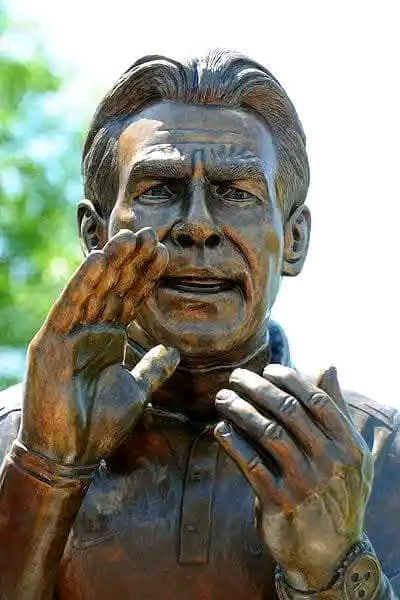
Unveiled in 2015 the statue of Nick Saban at the University of Alabama stands as a powerful tribute to one of the most iconic figures in college football history. Positioned outside Bryant-Denny Stadium, the bronze sculpture immortalizes a coach whose impact on the Crimson Tide program has been nothing short of transformative. More than just a statue, it is a symbol of excellence, leadership, and the relentless pursuit of greatness that Saban brought to Tuscaloosa.
The statue was designed by Jeremy Davis, a then-student at the University of Alabama, which makes its creation even more special and personal for the university community. His design was brought to life by master sculptor Jack Nortz of MTM Recognition, a firm well-known for crafting sports awards and monuments. Together, they created a work that captures the essence of Saban—not just his physical likeness, but the demeanor and determination that have defined his career.
Standing proudly with arms crossed and eyes focused, the statue depicts Saban in his signature game-day pose, a picture of calculated intensity. Every detail, from the wrinkle in his khakis to the furrow of his brow, reflects the meticulous nature of his coaching style. Unlike statues that seek to romanticize or exaggerate, this piece presents Saban as he is: focused, driven, and commanding.
The decision to erect a statue in his honor followed Alabama’s dominant 2009 national championship season—Saban’s first at the school. Under his leadership, the Crimson Tide returned to the summit of college football, rekindling the program’s storied tradition. The statue joined those of other legendary Alabama coaches, including Bear Bryant, in what is known as the Coaches Walk. By placing Saban among these giants, the university acknowledged that his contributions were not only immediate but enduring.
What makes this statue particularly significant is its role in a living history. Unlike many monuments that honor the deceased or retired, Saban was actively building his legacy at the time of the statue’s unveiling—and continued to do so in the years that followed. He would go on to win multiple additional national championships, cementing his status as one of the greatest coaches in the sport’s history. The statue, therefore, represents both a recognition of past achievement and an ongoing narrative of success.
Beyond the football field, the statue speaks to the cultural importance of the sport in the South, especially at a place like Alabama, where football is woven into the fabric of life. For fans, alumni, and players alike, the statue serves as a rallying point and a reminder of what is possible with discipline, vision, and relentless effort.
In bronze, Nick Saban’s legacy is preserved for generations. It tells a story of leadership and triumph, carved not just in metal, but in the hearts of those who cheer for the
Crimson Tide.






